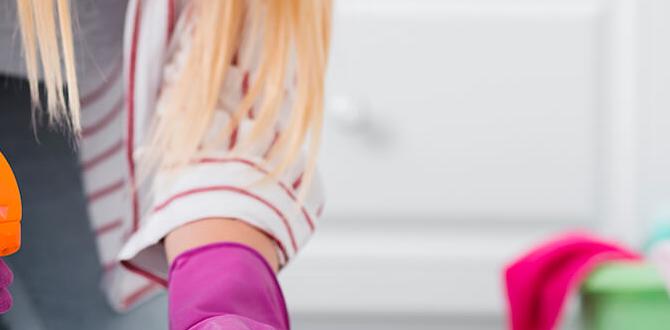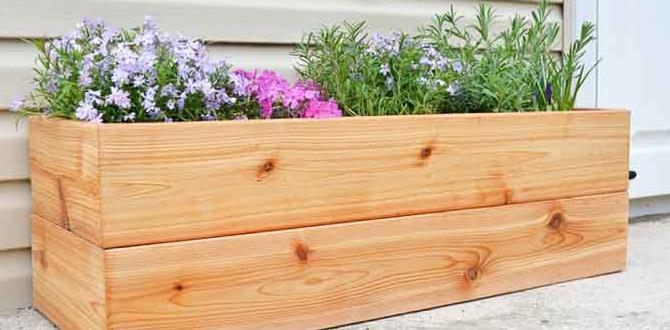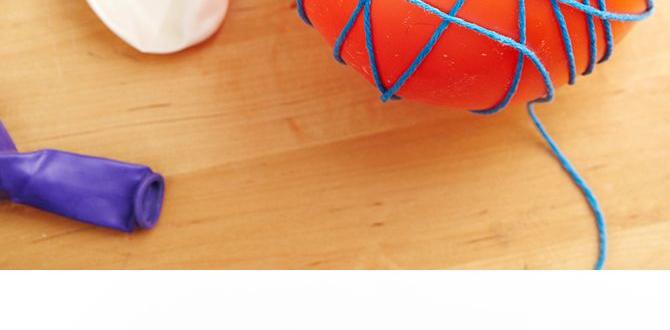Have you ever thought about how beautiful bamboo floors can look? Staining bamboo floors can bring out their natural charm. But how do you do it? Many people wonder about the best ways to make their bamboo floors shine.
Imagine walking on a stunning floor that catches everyone’s eye. Staining bamboo floors is an easy way to achieve that look! With the right techniques, you can change the color and enhance the grain of the bamboo.
Did you know that bamboo is one of the strongest materials? It grows quickly and is eco-friendly. This makes it a popular choice for flooring. Yet, many forget that it also needs care, especially when it comes to staining.
In this article, we will explore tips, tricks, and the best products for staining bamboo floors. Get ready to learn how to transform your space and make it even more inviting!
Table of Contents
Staining Bamboo Floors: Tips And Techniques For Success

Staining Bamboo Floors
Staining bamboo floors can completely transform your living space. Do you want to enhance the natural beauty of your bamboo? Different stain colors can create unique looks, from warm browns to cool grays. First, sand the surface to prepare it well. Then, apply the stain evenly for a stunning finish. Remember to let it dry fully to avoid any mishaps. A fun fact: bamboo is not only beautiful but also eco-friendly! Staining can make your floors not just beautiful but also personalized.Understanding Bamboo Flooring
Types of bamboo flooring: solid vs. engineered. Advantages of bamboo as a flooring option.Bamboo flooring offers two main types: solid and engineered. Solid bamboo is made from thick stalks and is very strong. Engineered bamboo, on the other hand, has layers that add stability. Both types are great choices! Why? Because bamboo is eco-friendly and grows fast like a superhero on a mission. Plus, it’s harder than oak, making it durable. So, your floor will withstand all those dance parties!
| Type | Strength | Durability |
|---|---|---|
| Solid Bamboo | Very strong | Long-lasting |
| Engineered Bamboo | Strong enough | Sturdy and stable |
Choosing the Right Stain for Bamboo Floors
Types of stains: oilbased, waterbased, gel stains. Factors to consider: color, sheen, and durability.When picking a stain for your bamboo floors, keep a few things in mind. You can choose from oil-based, water-based, or gel stains. Oil-based stains give a rich color but take longer to dry. Water-based stains dry quickly and are easier to clean up. Gel stains stay on top and are great for controlling color. Next, think about color, sheen, and durability. Bright colors can be fun, but make sure they actually match your furniture. A high sheen might be shiny like your grandma’s disco ball, but it can show scratches easily!
| Type of Stain | Drying Time | Ease of Cleanup |
|---|---|---|
| Oil-based | Slow | Hard |
| Water-based | Fast | Easy |
| Gel Stain | Moderate | Moderate |
And remember, your floors deserve some love too! Choose wisely, and your bamboo will not only look great but will also last for years!
Preparing for the Staining Process
Tools and materials needed for staining bamboo floors. Steps for cleaning and preparing the surface.Before you begin staining your bamboo floors, gather some important tools. You’ll need sandpaper, a brush, a roller, wood stain, and a clean cloth. Think of it as preparing for a fun cooking show, but you’re the chef and the floor is your dish!
| Tools | Materials |
|---|---|
| Sandpaper | Wood Stain |
| Brush | Clean Cloth |
| Roller |
Next, clean your bamboo floors. First, sweep up dust and dirt. Then, wipe them with a damp cloth. Think of this as giving your floor a nice spa day! This will help the stain stick better, making your floors look fabulous.
The Staining Process: Step-by-Step
Application techniques: brush, roller, or sprayer. Tips for achieving an even finish.Begin the staining process by choosing a method: brush, roller, or sprayer. Each method has its benefits. A brush allows for careful application, while a roller covers large areas quickly. A sprayer can reach tough spots easily.
To get an even finish, keep a few tips in mind:
- Use smooth, consistent strokes.
- Work in sections to avoid overlaps.
- Check for drips and wipe them up right away.
These simple steps will help your bamboo floors look beautiful!
How can I achieve an even finish when staining bamboo?
To achieve an even finish, apply the stain in long, smooth strokes. Move quickly and keep an eye on your work. Check for any drips and fix them before they dry.
Drying and Curing Times
Recommended drying times for different stain types. Factors that affect drying and curing times.Drying and curing times can change based on the type of stain used. Water-based stains often take around 2-4 hours to dry. Oil-based stains may need about 6-8 hours. Temperature and humidity also affect these times. Warmer, dry spaces speed up drying, while cold, humid areas slow it down. Always check your stain instructions for the best results!
What are the factors affecting drying and curing times?
Several factors can change the drying time.
- Humidity: High moisture slows drying.
- Temperature: Heat speeds up the process.
- Airflow: Good air circulation helps stains dry faster.
Following the right steps ensures your bamboo floors shine brightly!
Maintaining Stained Bamboo Floors
Cleaning and care tips for longevity. Recommended products for maintenance.To keep stained bamboo floors looking great, regular care is essential. Always sweep or vacuum to remove dust and dirt. For deeper cleaning, use a damp mop with a safe floor cleaner. Avoid harsh chemicals that might damage the floor finish.
- Use soft-bristled brooms for sweeping.
- Choose pH-balanced cleaners for mopping.
- Wipe spills immediately to prevent staining.
- Place rugs in high-traffic areas for extra protection.
For best results, consider products specifically made for bamboo flooring. These tips help maintain the beauty of your home.
What products are best for bamboo floor maintenance?
Look for pH-balanced cleaners that are safe for hardwood flooring. Natural oils can also nourish the bamboo.Recommended Care Products:
- Bamboo floor cleaner
- Soft microfiber mop
- Furniture pads
Common Mistakes to Avoid
Frequent errors during the staining process. How to troubleshoot issues with stain application.Staining bamboo floors isn’t always a walk in the park, so let’s dodge those common blunders! First, applying too much stain can turn your floors into a sticky disaster. Remember, less is more! Mixing your stain poorly can lead to uneven colors. Want to fix a hiccup? If you see streaks, don’t panic. Lightly sand the area and restain it. Finally, always test a small patch first—nobody wants surprise polka dots on their shiny new floor!
| Error | Solution |
|---|---|
| Too Much Stain | Use less and apply multiple thin coats. |
| Poor Mixing | Stir well before applying to avoid uneven colors. |
| Streaks | Sand lightly and restain the affected area. |
FAQs about Staining Bamboo Floors
Addressing common concerns and misconceptions. Answers to frequently asked questions from homeowners.Many homeowners have questions about staining bamboo floors. Misconceptions can lead to mistakes. Answering these FAQs helps clear confusion and guide you. For example:
Can bamboo floors be stained?
Yes, bamboo floors can be stained. This change can enhance the wood’s beauty.
What stains work best on bamboo?
Oil-based stains and water-based stains are great options. They soak in well and provide a deep color.
Is it hard to stain bamboo floors?
Staining bamboo floors isn’t very hard, but preparation is key. Sanding first helps the stain stick better.
Conclusion
In summary, staining bamboo floors can enhance their beauty and protect them. Choose the right stain to match your style. Always prepare the surface for the best results. Don’t forget to follow maintenance tips for longevity. Now that you know the basics, consider trying it yourself or read more for detailed guides! Enjoy your beautiful bamboo floors!FAQs
What Are The Best Types Of Stains To Use On Bamboo Floors For Optimal Color And Durability?For bamboo floors, water-based stains are best. They come in many colors and dry quickly. You should also look for stains that are flexible and resist scratching. Pigment stains can give deep colors that look nice and last long. Make sure to seal the stain after to protect your floor!
How Can I Properly Prepare Bamboo Floors Before Applying Stain To Ensure An Even Finish?To get bamboo floors ready for stain, you should first clean them well. Sweep or vacuum to remove dirt and dust. Next, lightly sand the surface to make it smooth. After sanding, wipe off any dust with a damp cloth. Now your floors are ready for a nice, even stain!
Are There Specific Techniques For Applying Stain To Bamboo Floors That Differ From Hardwood Flooring?Yes, there are different ways to stain bamboo floors compared to hardwood floors. First, bamboo needs a special cleaner before you stain it. Next, you should use a brush or cloth to spread the stain evenly. Lastly, let the stain dry completely before walking on it. This helps the bamboo look good and stay strong.
How Long Does It Typically Take For Stain To Dry On Bamboo Floors Before Applying A Topcoat Or Sealer?It usually takes about 1 to 3 hours for stain to dry on bamboo floors. You should check if it feels dry to the touch. If it’s sticky, wait longer. Once it’s dry, you can apply the topcoat or sealer. Remember to follow the instructions on the stain bottle for the best results!
Can I Change The Color Of My Bamboo Floors With Staining, And What Factors Should I Consider Before Doing So?Yes, you can change the color of your bamboo floors by staining them. But first, check if your bamboo is solid or engineered. Solid bamboo stains better than engineered. Also, think about the original color and how dark or light you want it. Lastly, do a test patch to see if you like the new color before doing the whole floor.
{“@context”:”https://schema.org”,”@type”: “FAQPage”,”mainEntity”:[{“@type”: “Question”,”name”: “What Are The Best Types Of Stains To Use On Bamboo Floors For Optimal Color And Durability? “,”acceptedAnswer”: {“@type”: “Answer”,”text”: “For bamboo floors, water-based stains are best. They come in many colors and dry quickly. You should also look for stains that are flexible and resist scratching. Pigment stains can give deep colors that look nice and last long. Make sure to seal the stain after to protect your floor!”}},{“@type”: “Question”,”name”: “How Can I Properly Prepare Bamboo Floors Before Applying Stain To Ensure An Even Finish? “,”acceptedAnswer”: {“@type”: “Answer”,”text”: “To get bamboo floors ready for stain, you should first clean them well. Sweep or vacuum to remove dirt and dust. Next, lightly sand the surface to make it smooth. After sanding, wipe off any dust with a damp cloth. Now your floors are ready for a nice, even stain!”}},{“@type”: “Question”,”name”: “Are There Specific Techniques For Applying Stain To Bamboo Floors That Differ From Hardwood Flooring? “,”acceptedAnswer”: {“@type”: “Answer”,”text”: “Yes, there are different ways to stain bamboo floors compared to hardwood floors. First, bamboo needs a special cleaner before you stain it. Next, you should use a brush or cloth to spread the stain evenly. Lastly, let the stain dry completely before walking on it. This helps the bamboo look good and stay strong.”}},{“@type”: “Question”,”name”: “How Long Does It Typically Take For Stain To Dry On Bamboo Floors Before Applying A Topcoat Or Sealer? “,”acceptedAnswer”: {“@type”: “Answer”,”text”: “It usually takes about 1 to 3 hours for stain to dry on bamboo floors. You should check if it feels dry to the touch. If it’s sticky, wait longer. Once it’s dry, you can apply the topcoat or sealer. Remember to follow the instructions on the stain bottle for the best results!”}},{“@type”: “Question”,”name”: “Can I Change The Color Of My Bamboo Floors With Staining, And What Factors Should I Consider Before Doing So? “,”acceptedAnswer”: {“@type”: “Answer”,”text”: “Yes, you can change the color of your bamboo floors by staining them. But first, check if your bamboo is solid or engineered. Solid bamboo stains better than engineered. Also, think about the original color and how dark or light you want it. Lastly, do a test patch to see if you like the new color before doing the whole floor.”}}]}






